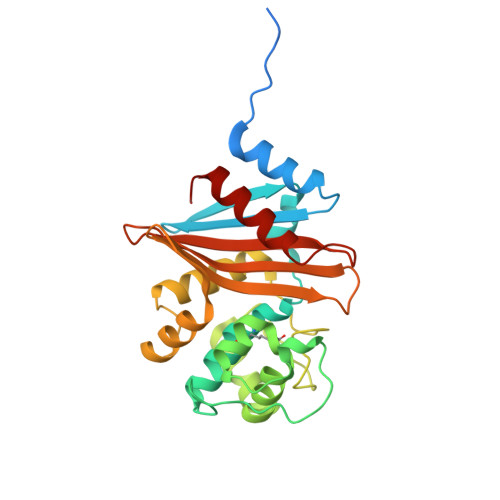Dual mechanism of the OXA-23 carbapenemase inhibition by the carbapenem NA-1-157.
Toth, M., Stewart, N.K., Quan, P., Khan, M.M.K., Cox, J., Buynak, J.D., Smith, C.A., Vakulenko, S.B.(2025) Antimicrob Agents Chemother 69: e0091825-e0091825
- PubMed: 40833279
- DOI: https://doi.org/10.1128/aac.00918-25
- Primary Citation of Related Structures:
9NSW, 9NSX, 9NSY, 9NSZ, 9NT0 - PubMed Abstract:
Carbapenem-resistant Acinetobacter baumannii continues to be a leading cause of life-threatening infections that result in high mortality rates. The major cause of carbapenem resistance in this pathogen is the production of class D carbapenemases, enzymes that inactivate the last resort carbapenem antibiotics, thus significantly diminishing the available therapeutic options. In this study, we evaluated the interaction of OXA-23, the most widely disseminated class D carbapenemase in A. baumannii clinical isolates, with the atypically modified carbapenem, NA-1-157. The MICs of this compound against strains producing OXA-23 were reduced from highly resistant levels observed for the commercial carbapenems meropenem and imipenem (16-128 µg/mL) to sensitive or intermediate levels (2-4 µg/mL). Kinetic studies showed that NA-1-157 inhibits the enzyme due to a significant decrease (>2,000-fold) in the deacylation rate relative to its closest structural analog, meropenem. Structural studies and molecular dynamics simulations demonstrated that inhibition is caused by both the inability of a water molecule to get close enough to the scissile bond to perform deacylation and by partial decarboxylation of the catalytic lysine residue upon formation of the acyl-enzyme intermediate.
- Department of Chemistry and Biochemistry, University of Notre Dame, Notre Dame, Indiana, USA.
Organizational Affiliation:



















